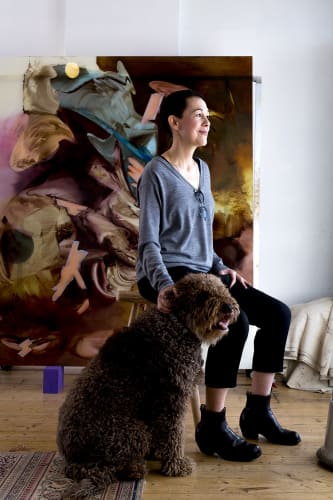Harnessing the contemporary aesthetic of mediated visuality, whilst acknowledging that painting is, equally indebted to art history, her work acknowledges the influence of the screen-paradigm through notions relating to painting as object/surface and the perception of interactivity, relating to a virtual form of tactility. Traversing the paradox between the prohibition of touch in relation to digital technology and art – and an erotic’s of painting, interactivity relates to seduction: a correlation that enacts the ‘erotics’ of painting, and seeks to engage the viewer immediately in a tactile participation, close and yet distancing at the threshold of vision and touch, while simultaneously providing the viewer with a variable experience of scale.
Structurally and aesthetically functioning along the lines of a screen, these paintings aim to incorporate some of the same spectatorial conditions established by a new screen paradigm, such as notions of movement and fluidity, arrested and caught within a painting frame, and the utilisation of a type of perception based on the fragmentary nature of vision.
Artist Statement:
Hannah’s work speaks of fluidity, object/surface and the perception of interactivity relating to a virtual form of tactility. Traversing the paradox between the prohibition of touch in relation to art – and an erotic’s of painting, interactivity relates to seduction: a correlation that enacts the ‘erotics’ of painting, and seeks to engage the viewer immediately in anaesthetics of the feminine, utilising tactile participation, close and yet distancing at the threshold of vision and touch.
Her practice including paintings, installations and soundscapes, demands more than our capacity to critique; it demands our bodies, the slow trail of an eye-finger... It is therefore not possible to view her work without incorporation, reflection, multiplication; offering an alternative to ways of seeing, which demands a particular distance between subject and object, a vacillation, tactility. The viewing experience takes place as if between (at least) two subjects, and leads us on to consider intersubjective relations, in an attempt to mobilize a possible other ‘female imaginary’.

